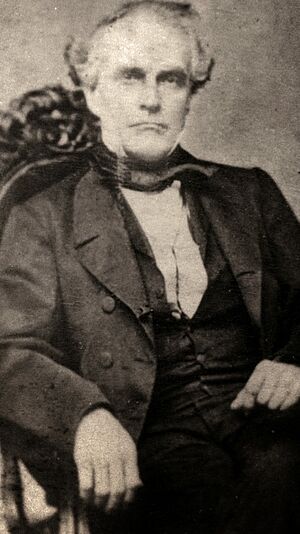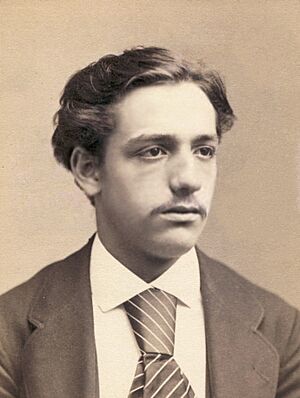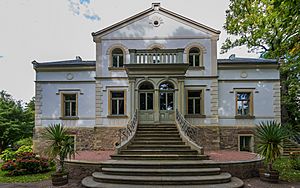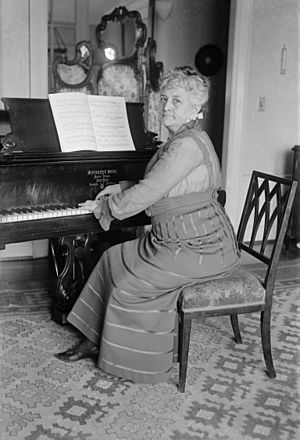Teresa Carreño facts for kids
Quick facts for kids
Teresa Carreño
|
|
|---|---|
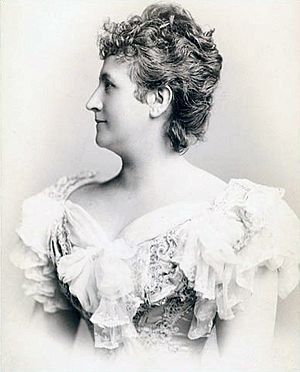 |
|
| Born |
María Teresa Gertrudis de Jesús Carreño García
December 22, 1853 Caracas, Venezuela
|
| Died | June 12, 1917 (aged 63) New York City, U.S.
|
| Occupation | Pianist, soprano, composer, and conductor |
| Spouse(s) | Émile Sauret (m. 1873–1877), Giovanni Tagliapietra (dom. part. 1877–1889), Eugen d'Albert (m. 1892–1895), Arturo Tagliapietra (m. 1902–1917) |
| Children | Emilita (1874–1978), Luisa (1878–1881), Teresita (1882–1951), Giovanni (1885–1965), Eugenia (1892–1950), Hertha (1894–1974) |
María Teresa Gertrudis de Jesús Carreño García (December 22, 1853 – June 12, 1917) was a famous Venezuelan musician. She was an amazing pianist, a soprano singer, a composer (someone who writes music), and a conductor (someone who leads an orchestra).
For 54 years, Teresa Carreño performed concerts all over the world. She was known as a "virtuoso" pianist, meaning she was incredibly skilled. People often called her the "Valkyrie of the Piano" because of her powerful playing.
Teresa Carreño helped make the music of her student, American composer Edward MacDowell, famous. She played many of his pieces for the first time in different countries. She also often performed music by the Norwegian composer Edvard Grieg. Carreño herself wrote about 75 musical pieces, including works for piano, voice, choir, and orchestra. Other composers, like Amy Beach and Edward MacDowell, even dedicated their own music to her.
Contents
Becoming a Musician: Early Life and Training
María Teresa Carreño García de Sena was born in Caracas, Venezuela, on December 22, 1853. Her father, Manuel Antonio Carreño, came from a musical family. He was her first music teacher and guided her career. Her mother, Clorinda García de Sena y Rodríguez del Toro, was a cousin of the wife of Simón Bolívar, a very important leader in South America. Teresa was named in her honor.
Before leaving Venezuela, Teresa also studied with a German musician named Julio Hohene. Later, in America, she took voice lessons from Hermine Küchenmeister-Rudersdorf.
A Star is Born: Early Career and Performances
In 1862, when Teresa was just eight years old, her family moved to New York City. She quickly became part of the music scene, giving many private and public concerts. Soon after arriving, she met American pianist Louis Moreau Gottschalk. He heard her play and helped her become known as a talented artist.
On November 25, 1862, Teresa made her official debut at Irving Hall. She played several difficult pieces and even performed an encore. After this, she gave concerts across the eastern United States from 1863 to 1865. She played in places like Connecticut, Massachusetts, and Washington, D.C. In the fall of 1863, she even performed for President Abraham Lincoln at the White House! She also gave concerts in Cuba during this time.
Conquering Europe: Paris and Beyond
In 1866, Teresa and her family moved to Paris, France. She made her debut there on May 14 at the Salle Érard. In Paris, she met many famous musicians, including Gioachino Rossini and Franz Liszt. She performed regularly in the United Kingdom, France, and Spain between 1866 and 1872.
While in Paris, she studied singing with Rossini. Later, she continued her voice lessons with other teachers. Her training was so good that she even stepped in to sing an opera role as the Queen in Meyerbeer's Les Huguenots when the main singer became sick. In 1876, she sang another opera role in New York, playing Zerlina in Mozart's Don Giovanni.
Returning to America and Family Life
In 1872, Teresa returned to the United States with a group of famous musicians. While touring, she fell in love with French violinist Émile Sauret. They married in London in 1873 and had a daughter named Emilita. Emilita was raised by a family friend while Teresa and Émile continued their music careers.
Between 1876 and 1889, Teresa lived and toured mostly in the United States. She performed with many famous opera singers and musicians. After her marriage to Sauret ended, she had a relationship with Giovanni Tagliapietra. They had three children: Louisa, Teresita, and Giovanni. Teresita became a concert pianist like her mother, and Giovanni became an opera singer.
During these years, Teresa often played with famous orchestras like the Theodore Thomas Orchestra. She performed solo piano concertos, including pieces by Felix Mendelssohn and Edvard Grieg. By 1883, she started playing and promoting the music of Edward MacDowell in the United States and later around the world. She often played his First Modern Suite and his Piano Concerto No. 2, which was dedicated to her.
A Visit Home: Venezuela
In 1885, the president of Venezuela, General Joaquín Crespo, invited Teresa and Giovanni Tagliapietra to Caracas. They hoped to start an opera company and a music school. Teresa gave several concerts, including one where she played her own piece, Himno a Bolívar, which she wrote for Venezuela's founding father.
They returned to Venezuela in 1887 to open their new opera company. However, their efforts didn't work out well because of political problems and unhappy audiences. They went back to New York in August 1887 and continued performing in the United States.
Success in Europe and Later Years
Teresa Carreño had always wanted to become a top pianist in Europe. On November 18, 1889, she made her debut with the Berlin Philharmonic orchestra. She played pieces by Edvard Grieg, Robert Schumann, and Carl Maria von Weber. She became very successful in Germany and worked with the Hermann Wolff Concert Bureau, becoming good friends with Hermann Wolff and his wife.
Around 1890, Teresa met German pianist and composer Eugen d'Albert. They became close and moved into a home they called Villa Teresa. They married in 1892 and had two daughters, Eugenia and Hertha. They often performed concerts together, and Teresa started playing d'Albert's music. However, d'Albert was very controlling, even about her music choices, and she stopped playing MacDowell's music during their marriage. Their marriage ended in 1895. In 1902, she married Arturo Tagliapietra, who was Giovanni's brother. He helped her with her concert plans.
After her success in Europe, Teresa Carreño returned to the United States in 1897 to an excited audience. A newspaper critic wrote that her "magnificent technique" showed off the piano's "marvelous sound." From then on, she was a featured artist in concerts, playing solo or with orchestras. She performed with many famous conductors, including Edvard Grieg, Gustav Mahler, and Henry Wood. Henry Wood wrote that Teresa "looked like a queen among pianists – and played like a goddess."
Teresa Carreño played music by many famous composers like Frédéric Chopin, Franz Liszt, Pyotr Ilyich Tchaikovsky, and Ludwig van Beethoven. She also sometimes played her own compositions. Between 1905 and 1908, she recorded over forty pieces for the reproducing piano. Her daughter Teresita also made recordings.
Teresa also taught music lessons to students in many cities she visited. Some students even traveled to her summer home to study with her. For the rest of her career, she performed across Europe, and visited North America, Australia, New Zealand, and South Africa.
In September 1916, Teresa Carreño returned to New York City for a concert season. In 1916, she performed for President Woodrow Wilson at the White House. In March 1917, she became ill during a trip to Cuba. She returned to New York and was diagnosed with a serious eye condition. Her health quickly worsened, and she became paralyzed. Teresa Carreño passed away on June 12, 1917, in her New York City apartment at 63 years old.
Musical Creations: Teresa Carreño's Compositions
Teresa Carreño wrote about 75 musical pieces. These included works for piano, voice and piano, choir and orchestra, and chamber music (music for a small group of instruments). She even included the Venezuelan dance style called merengue in some of her pieces.
Her earliest compositions date back to around 1860. One of her first published pieces was the "Gottschalk Waltz" (1863), which she dedicated to Louis Moreau Gottschalk. Most of her works were written before 1875 and published by different companies around the world.
After 1880, she composed only a few more pieces. These included two works for choir: Himno a Bolívar (around 1883) and Himno al ilustre americano (around 1886). Himno a Bolívar was played for the first time during her visit to Caracas in 1885. Her piece Kleiner Walzer (Mi Teresita), written for her daughter Teresita, was very popular. She often played it as an encore at her concerts. In the 1890s, she also wrote two chamber music pieces: Serenade for String Orchestra and String Quartet in B-minor.
Her Lasting Impact: Legacy
In 1938, Teresa Carreño's ashes were brought back to Caracas, Venezuela. In 1977, they were moved to the National Pantheon of Venezuela, a special place where important Venezuelan heroes are laid to rest.
Vassar College in the United States has many of Teresa Carreño's personal papers, including letters and documents. Some of her collection is also kept at the Centro Documental Teatro Teresa Carreño in Caracas.
The Teresa Carreño Cultural Complex in Caracas is a large arts center named in her honor. It is home to the Venezuela Symphony Orchestra. The complex also has a special archive, the Centro Documental, which holds her letters, concert programs, photos, and other personal items. There's also an exhibition room with her concert dresses, her Weber piano, and other belongings.
There is even a crater on the planet Venus named after Teresa Carreño!
In 2015, a film about her life, called Teresita y El Piano, began production. In 2018, Google Doodle celebrated her 165th Birthday with a special drawing.
Images for kids
See also
 In Spanish: Teresa Carreño para niños
In Spanish: Teresa Carreño para niños


